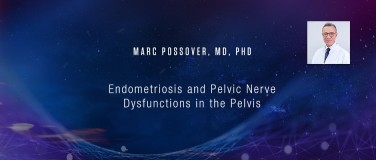David Redwine, MD - Origin of Endometriosis: Cartoon Science vs Evidence-based Medicine
Endometriosis Foundation of America
Medical Conference 2019
Targeting Inflammation:
From Biomarkers to Precision Surgery
March 8-9, 2019 - Lenox Hill Hospital, NYC
https://www.endofound.org/medicalconference/2019
Hello. My name is David Redwine. And I'm here to talk about the use of cartoons for science. We all know about reflux administration as the putative origin of endometriosis. Normal endometrium reflexes. Then, it adheres. It proliferates. It invades. It becomes an auto-transplant disease that we call endometriosis. This was recurrent because it occurs every month with the menstrual flow.
That's why you need to have hormonal therapy, and this is occurring by the billions. When you consider all the women with endometriosis in the world, all the women having menstrual flow all the time. This is by the billions. It's been occurring. Well, is endometriosis an autotransplant? Autotransplants remain identical to the tissue of origin in all of these characteristics.
An example of an autotransplant is a human ovary transplanted to the arm before pelvic radiation. You can do an ultrasound. You can retrieve follicle eggs from the follicles and so on. When I did this review of the literature in 2002, I found many, many differences of endometrium from ectopic endometriosis. Those dozens of differences have been multiplied into hundreds of more differences many genetic.
Endometriosis is not identical to the endometrium. It has all of these kinds of abnormalities. It's not an autograft. It's not an autograft. Still missing are the two steps of Sampson's theory that nobody appears with ready, willing, or able to find or even to look for, and that is the first stage of peritoneal attachment, and then secondary proliferation and invasion into the peritoneum to become endometriosis.
People have looked for initial attachment in proliferation and invasion. There were a series of microscopic endometriosis studies from the 80s and 90s. What they were looking for, we were looking for early stages of the disease that you can see here. The evidence from those microscopic endometriosis studies showed that no one found any evidence of initial attachment of reflux endometrium.
Proliferation and invasion of these attached cells did not occur. A physician from Tennessee, Dr. Clyde Martin, was apparently going around telling people that he'd found the evidence of initial attachment because he had found a ... Why isn't that advancing? I can't read. This isn't playing. There we go. He looked at this thing here and said, "Well, that's suspicious." He took a biopsy. He removed it by a biopsy, and it came back as endometriosis.
Well, is this really evidence of initial attachment? Let's apply my five criteria of normal peritoneum to this. It's not a smooth surface because it's got a polyp. It's got abnormal vascularity. There's bleeding and looks like a proliferation of some blood vessels. The peritoneum is not transparent. You can see that some of the blood vessels disappear behind these areas.
There are sub-peritoneal cystic structures. There's one here and there's one here. This is the endometriosis, and this is the endometriosis. This is a superficial endometriosis that happened to have an inflammatory polyp that formed in reaction to it. The blood vessels in that polyp show that it's not endometrium.
It's an exophytic vascular polyp formed in reaction to the inflammation of the adjacent peritoneal endometriosis. That's what was being biopsied was these areas right here that just was an innocent bystander. The theory of reflux menstruation predicts disease behavior over time. Well, it predicts what's called dandelions spread that over time you'd get more and more of the pelvis involved by endometriosis.
If you look at increasing ages, age groups of women and percent of patients that might have endometriosis of a particular area, you find that this is kind of what you would expect from reflux menstruation occurring every month, but this is what is found in the several most common areas of pelvic involvement.
Older age groups don't seem to have more pelvic areas of disease. Philip Konincks did a similar study. He measured the length and the width of endometriosis in the pelvis and got a surface area. He found much the same thing that the older age groups did not have more surface area of involvement than younger age groups. Ricardo Marana looked at the same thing looking at the revised AFS classification system. He found that older patients don't have higher stages of the disease.
Does the theory of reflux menstruation predict post-surgical behavior? Well, it's certainly, I share your pain over the advancing slides, the robots are in control. Excision leaves peritoneal damage which should facilitate adherence. Then, the question becomes, well, do the rate and amount of endometriosis in the pelvis increase over time after you excise? Is this what you would see and it's just a battle, a futile battle to try to remove all the endometriosis?
Well, what I found was looking at the quarterly recurrence after excision, there is a recurrence but it's kind of muted really in a way. It doesn't go up. These are quarters. That's four years. That's six years and so on so. There's a muted amount of recurrence that seems to occur. What about the number of pelvic areas at the time of reoperation? Well, it doesn't just go like that. It kind of bumbles across.
The amount of endometriosis found after excision does not seem to increase over time. Who was it that used the c-word earlier. The cure rate, the cure word. There have been several studies that have published cure rates following excision. The laparotomy cure rate was 66% and the laparoscopic excision ranges between 57 and 100% cure rate. A cure is defined in the traditionally acceptable way.
Patient has a disease. The disease is treated. The disease is gone, and the disease was proven to be gone by repeat laparoscopy in these series, none of which used routine post-op medical therapy for endometriosis. Is endometriosis simply displaced normally functioning endometrium? No. Does the attachment of endometrium occur after reflux menstruation? Apparently not. We're still waiting for the photomicrographs of a proof that Sampson theory occurs.
There's a peritoneal circulation arm of Sampson's theory that proposes a peritoneal circulation to explain slightly higher in the prevalence of left uterosacral ligament disease compared to the right uterosacral ligament. The explanation had to do with a presumed circulation, and the peritoneal cavity being interrupted by the sigmoid colon in the left lower quadrant so that reflux endometrium would be able to kind of pool in this little this protected area from the circulation.
The peritoneal circulation would be altered and so monthly sitting from the left tube would tend to accumulate and stay there, and have a chance to attach an implant and grow whereas cells on the right would be swept away by this peritoneal current. It's not clear whether this peritoneal current is propelled by propellers or cilia or what.
The evidence for this circulation was based on a radiological study by Dr. Myers in 1970, I think. He used the tilt table and what he did is he had 20 patients, and he injected their abdomens with radio-opaque dye. Then, he kind of shook him on the tilt table and he took x-rays to see where the dye would go.
This is the diagram that Dr. Meyers constructed from his studies, and you can see that depending on which way the tilt table went, you could make the dye go anyway and everywhere. Apparently, these were males because there was no uterus in the picture. Here is his original diagram, and there was a publication that came out several years ago which proposed that there was this clockwise circulation.
What they did is they took this diagram, and they made at least eight alterations to get the diagram erasing and adding arrows wherever they wanted in order to construct the idea that there is a clockwise peritoneal circulation. That is fabricated cartoon science. Some might call it scientific misconduct. I'll just call it cartoon science
But by adding or deleting arrows, see what I've done here, I've erased all the arrows going clockwise with arrows going counterclockwise, so using the same methodology of that scientific publication. I have proven that there is a counterclockwise circulation. A clockwise circulation would be incorrect in the northern hemisphere anyway because of the Coriolis effect.
This is a photograph of a hydrogen atom. This is not a cartoon. This is a hydrogen atom. Why are physicists able to take photographs of hydrogen atoms when we can't take photographs of thousands of cases of initial attachment, and more thousands of cases of proliferation and invasion? We have thousands and millions of pictures of established endometriosis but not the two preceding steps.
Well, does attachment occur only in the dark? Surgery is done with lights, and maybe those cells are photo-phobic and kind of run away, or maybe it's too quick to photograph. I don't know. Let's see if I can slow this down for you and show you the origin of ... There it is. That's an initial attachment. I've not seen any cartoon that can go against this. This is a fine cartoon. I made up myself. It's got a Tinkerbell. It's got a little sad face. It's got little jack-o'-lantern. It's a fine cartoon that I think will assume its place in the pantheon of cartoon supporting reflux ministration.
Well, I think reflux menstruation I'll just say it is the most dangerous theory in the history of medicine ever. Is it a theory or is it our excuse for ineffective treatment of generations of women? It's cartoon science. Let's talk about where endometriosis comes from. Let's talk about the embryonic origin of endometriosis.
GWAS studies, you heard a little bit about them, identified several candidates, things to look at and when you look at the functions that are associated with these things that are present in higher numbers, embryonic development, estrogen response, angiogenesis, cell proliferation. There's a Hox gene thrown in there for overall body plan work, gene silencer, a tumor suppressor.
There are these things that are going on that prime the pump so to speak for that embryo development of endometriosis. Also, there has to be an attractiveness gene to increase exposure to conception as virtually any found women with rectovaginal endometriosis have earlier intercourse than women without. You would think that for something like endometriosis that can interfere with fertility, women have to have something that allows them to reproduce or enhances their ability to reproduce.
That's where the attractiveness gene may come in. Also, since it occurs in males, the Y chromosome may be involved. Beyond all these single nucleotide polymorphisms and GY studies, there's deregulation of micro-RNA transcription factors. It just goes on and on. You're going to need a computer to figure all that out.
The point is there's a complex mulleriotic genetic load. At the moment of conception, the egg and sperm combine under those loads. The embryo from the get-go is carrying this genetic message to produce endometriosis of some type, some stage, some location depending on the innate fate that's inborn.
At day 15, gastrulation begins, and epiblast cells for the blue area are converted to mesoderm after passing through the primitive groove. Mesoderm forms coelom in its lining, the uterus tubes, and ovaries, bladder, kidney, prostate, bone marrow, in other words, the mesoderm forms every location that endometriosis has been found except two. I'll tell you those later.
These genetic mulleriosis traits manifest this formation of defective mesoderm. Endometriosis is a manifestation of defective mesoderm that was laid down during embryogenesis. This is what gastrulation looks like. You can see here's the primitive groove right here. The cells are just going and falling through that groove to become mesoderm. These cells who knows what kind of genetic messages they are carrying with them as they fall down and become mesoderm.
Here is another chicken gastrulation showing a different view of mesoderm spreading as the embryo develops. You can almost see, imagine that some of these things might represent endometriosis in the human or where endometriosis might be deposited in the human. You can see as we've just heard, they're controlled by the notch and other types of signaling.
What this means is you get these mesodermal migration tracts that are laid down, and they carry the defective mesoderm in those tracts. This is how I diagrammed it back in the 80s when I was coming up with this, basically, the G stands for gonad. U stands for uterine. E stands for endometrium, and all the cells were jumbled at first, and as they go down to the pelvis to form the uterus and ovaries, some don't make it and the problem of differentiation and migration that is primed by the genetic problems leaves the endometriosis in the typical areas, the patterns that are familiar to all endometriosis surgeons.
Here's another view of the embryo. Notice here, there is epithelial down growth, the epithelial end growth that goes from the coelomic epithelium into the ridge there, and this can create gradients of susceptible fields that can either carry endometriosis or carry the possibility of metaplasia into fibromuscular disease surrounding deep endometriosis. These endometriosis tissue tracts. They're familiar to all endometriosis surgeons. You know about them if you do the surgery.
They may have rests or metaplasia capabilities, and it's important to realize that this mesodermal process, this abnormal mesodermal process would result in endometriosis being laid down that looks more basic than the differentiated endometrium in the uterus. Endometriosis laid down like this would more resemble basalis endometrium than functional endometriosis.
Other people have ... Other authors have started to come onto the embryonic origin bandwagon. Serdan Bulun talked about the abnormalities of methylation that he identified, didn't seem like they could be explained by reflux menstruation. He postulated an embryonic process going on seeing they're really in [inaudible 00:17:38] found that 11% of the embryos he looked at had findings suggestive of endometriosis.
I found 11% of the specimens of newborns dying of sudden infant death syndrome, 11% of those had what looked like endometriosis in the cul de sac. These tracts of tissue, for instance, in the uterosacral ligaments here can be either superficial or deep, and the tracts of tissue can contain any Mullerian tissue.
Endometriosis just happens to be the most common and the most symptomatic, but it can be fimbria as you see here. It can be endocervicosis. It can be endosalpingiosis. It's not just endometriosis.
These embryologically patterned mesodermal tracks occur on the anti-mesenteric side of the bowel often or on the antisalpingeal side of the tube with biological variation. There's going to be a kind of other areas but any endometriosis surgeon who does intestinal work is struck by how often it's on the anterior side of the rectus sigmoid and even on the anterior side of the ileum in a line as it were.
The posterior pelvis is the most common area of involvement not because of gravity. It's because that's the pathway of organogenesis during embryonic formation. Then, there can be fibromuscular metaplasia of parenchymal sites such as uterosacral ligaments around ligaments, bladder, and bowel. These tracks can undergo metaplasia as you see here on the ovary. I'm sorry I'm showing pictures.
I could go back to cartoons, but we've seen enough cartoons in our careers about Sampson's theory, and I'm just going to keep on showing photographs. This mesodermal migration problem can result in hidden seating of the colon. It can result in hidden seating of the ovary as found by Russell, and it can result in hidden seating of endometriosis in lymph nodes. All those things are formed from mesoderm.
Again, the number of people that are coming across to the embryonic origin side are increasing, and I hope there'll be a few more dozen today. My personal path to the embryonic origin began with my first publication back in 1987. That was before Al Gore invented the internet. What I found was that the endometriosis was positionally static. Older age groups didn't have more disease.
I thought Sampson might be wrong. When you think about it, Sampson didn't have a lot of experience with endometriosis. He saw maybe 400, maybe 500 cases. Most of them kind of advanced disease. He did the best he could. The second publication, I documented the prevalence of subtle disease and realized that since endometriosis can change in visual appearance overtime that if somebody doesn't know what subtle disease looks like, they're going to miss it at one surgery that might see it at another surgery.
They have the appearance of new disease when, actually, the disease that was there just became more obvious and manifest. These two studies prompted me to do the newborn SIDS death study finding apparent endometriosis in the cul de sac of one out of nine. The pattern tracts were also something that came from my pelvic mapping studies. It occurred to me early on that because of these pattern tracts, endometriosis can be cured by excision if all tracts are completely removed.
Excision in my career became a manifestation of the basic science of endometriosis, the basic clinical science of endometriosis. Lo and behold, I found that in the study that you just saw slides of, yes, the cure rate was 57% among those patients that had a reoperation. The point there being that you can win the endometriosis battle, but you can lose the pelvic pain war because there are other things besides endometriosis that can cause pain.
You can cure it if it's all removed whether it's superficial as you see here or deep, but this is not new. We've known. Everybody's known since the 50s, 1950s when black-and-white television was all we had. Joe Meigs said that recurrence is not frequent and cure by conservative surgery as usual, and that's exactly what we're seeing today, cure as possible.
A bright line has been created in the profession. On this side is embryonic and, therefore, a genetic origin. On this side is a postnatal autograph that would relate to reflux menstruation. What we're seeing is we're seeing convergence. We're seeing different authorities arrive at a similar conclusion from different directions in different epochs of time and in different hemispheres.
They come to the embryonic origin of endometriosis conclusion. I've probably left other people off this list, but it's a list that is growing. In contrast, we have reflux menstruation as the origin of endometriosis. We have divergence where you have publications that highlight increasingly large and unreconciled differences. You have supporters who are reduced to cartoon's fantasy fabrication of evidence and scientific misconduct.
I think our patients deserve better than that. I wrote this in 1988. I'll read it again here. The implantation theory will remain a gynecological windmill before which successive generations of theorists will joust and that's what I'm still seeing today. I mean it's like we need to get off this Sampson's Theory thing or at least I want to see tens of thousands of photomicrographs of initial attachment, and I want to see tens of thousands of pictures of secondary proliferation and invasion of the peritoneum. Where are they? Are the people who believe in Sampson's theory, they have this evidence but they're suppressing it, or does the evidence not exist? That's why when people look for it, they've not found it.
Needed in the future, lots of things are needed in the future. First thing is the abandonment of reflux menstruation as the origin of any form of endometriosis. We need more surgery. We need more surgery in order to cure our patients by moving their pattern tracts of disease. We need surgery to augment genetic research. We need a pelvic location-specific analysis. In other words, is everything going on over here in the pelvis the same as over here and over here whether it's gene function expression, protein production, et cetera?
What does endometriosis secrete? I mean it's got all this stuff that's being secreted. Somebody needs a stick a micropipette in there and get about three or four gallons and see what's going on. We just still don't know. Max Planck said a new scientific truth does not triumph by convincing its opponents but rather because its opponents eventually die. We also need more cemeteries. Thank you. We'll take questions. Yes.
A patient former patient of Dr. Two questions. What exactly is reflux menstruation? If I'm a patient and a doctor thinks that's that but I want to challenge him and be educated because I've been informed that this is a fallacy, what would the doctor be telling me that I should then challenge, question one.
Question two, we've talked a lot about symptoms but what about women who are asymptomatic?
What to tell the doctor or what to discuss with the doctor?
Like what would a doctor say to a woman-
Who comes in with this kind of a stories thing.
... with ... If he thought reflux menstruation was a thing like he probably wouldn't say you have reflux menstruation, and therefore, blah, blah, blah. What words would he be using?
Well, I wouldn't even talk about the origin with them because what it boils down to for you in that doctor's office is what kind of treatment are you going to get. Are you going to get excision or you're going to get medical therapy? Those are the two observations. Do nothing. But so regardless of where it comes from, you're still stuck with those very few things to discuss with the physician.
I wouldn't bring up something like this at all. You can smirk and say, "Well, he thinks something that's 100 years old and blah, blah, blah." But you're not going to win any points by trying to argue the theory of origin. Just try to get down to the basics of what is he going to do to the disease. What was the second part of your question?
What if you are completely asymptomatic.
I've had some asymptomatic patients. Their only symptom was infertility, unexplained infertility because they were ovulating sperm count with normal tubes were open. I did a laparoscopy. I found minimal endometriosis. I removed it, and the patients came back later and said, "I thought I didn't have any symptoms, but now that I've had endometriosis removed, I understand that I was really having symptoms." Is asymptomatic disease the woman who is just better able to cope, bless her heart, with severe painful disease, so nobody's going to get any award points for ... You don't get any reward for coping.
I mean you get a reward for having the disease removed.
Katie Burnes. I have a kind of a chicken and an egg type question. Based on the embryonic origin of disease, only humans and non-human primates are who menstruate. Those seem to be the only ones who actually naturally have endometriosis, but we all form in a very similar pattern. Have you gone through on their species to figure out if they have endometriosis? Then, my second question would be why would this become endometriosis and not a form of cancer?
The best questions are those that have no answers. I don't know why endometriosis doesn't go on to become cancer more frequently than it does. The deep disease is at some risk of forming cancer versus superficial disease. It obviously has something to do with a genetic load that the woman got when she was conceived. I don't know how to answer it other than that. What was the other question you had/
Only humans and non-human primates menstruate and have an open reproductive system. There are other species that menstruate but there you have a closed reproductive system. My question is we all form on a very similar patterning mechanism through gastrulation. Why have we not seen endometriosis in these other species?
I have no idea. I just don't know.
I wanted to ask about the cure rate data. In the dozen or so studies that are cited and recently about three years ago did a review of all them as well. Let's go with the 57% cure rate. Those are all women who returned to the same surgeon for a reoperation.
They may have been to the same surgeon or different surgeons. In my case, if they went back to see another surgeon, I got the operative report, path report so I could compare that surgery with my surgery. The other papers, I'm not sure whether all reoperations were done by the authors or not. Go ahead.
Among those who either weren't reoperated on or who weren't captured in those pathology and surgery reports that you were able to obtain, how do we know what happened to those women? What were their outcomes?
Well, out of the 359 patients, well, of course, if you didn't capture them, you don't know what their outcomes are, but out of the 359 patients, I'd lost, I think, 32 to follow up, so I knew what happened to 90% of the patients that I had done surgery on at that point.
Other portion you didn't have a reoperation, how do you know, that the endometriosis isn't again present but not visualized but now they have actual remediation of their symptoms, so they didn't have an indication for repeat surgery.
I didn't understand your question.
If they had one surgery if they never had a follow-up surgery, how are you counting them in terms of whether endometriosis was cured or not?
Well, unless you re-operate, you don't because you can't go on symptoms. Symptoms can be due to anything. You can have dysmenorrhea from the uterus and no endometriosis. The important thing that I thought from these studies quoting the cure rates is that anybody would use the term cure at all and use it with such reasonably high percentages.
I was taught that endometriosis is incurable that the cure rate would be 0%. Even if the curate was 0% that, to me, would have been significant. The fact that it's between 50 and 100%, your arguments about loss to follow up and all factoring in, but among the people that were reoperated, most of them did not have endometriosis. To me, that is the most important fact rather than the actual percentage.
There's a high percentage, a healthy percentage, not 100%, how do we get it to 100%? I don't know. It relates to doing aggressive complete surgery I know that.
Well, I mean I have three concerns. The patient outcome that matters is the symptoms. In those we operate on, they all still have either a return of symptoms or persisting symptoms. They're not cured of the reason they presented for the surgery. Of those who are re-operated on, I agree that there's an absence of endometriosis, but there's an absence of endometriosis at that time point. If you re-operated two years after that, maybe there would still be, now maybe now there would be a return of endometriosis.
I think we need to be very precise about a cure because we've seen this literature cited a lot.
I don't know what else-
... interpreted as cure rate for that's the patients can expect of symptoms.
Well, I don't know what else to call it. We could call it ovarian cancer because they don't have any evidence of that either. If we're going to call something that it's not despite evidence of what it is, then it's like we have no hope. We're lost in a sea of words that don't mean anything because numbers are lost.
If somebody has no endometriosis, what word should we use? We can't use remission because we don't know what's going to happen for the future at that time they're cured.
Well, I would argue that the patient thinks that those numbers mean that they're cured of the reason they had the surgery which was the symptoms which isn't the case.
Well, I'm not here to talk about symptoms per se. I was just talking about cure rates. That conversation is something that the patient has to have with their surgeon I'm not responsible for what physicians tell their patients. All I know is the traditional medical term for cure relates to a disease that was treated and was no longer present.
If we're going to use a non-traditional definition of cure, I'm not sure that I'm ready to throw away the traditional definition of cure-
I think we're closed on that.
Good.
…. because those of us who think cure involves both endometriosis and pain and other people who say it's okay to keep having pain because I got rid of the endometriosis, and we'll have lunch and we'll come back later. Thanks to all the speakers this morning.










